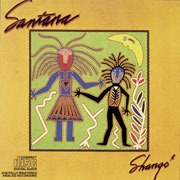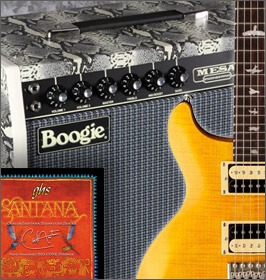During his more than 40-year career, Carlos Santana has gone through a number of phases. First, the percussion-fueled early albums (Santana by Santana, and Abraxas), followed by an experimental jazz period (Caravanserai, Love Devotion Surrender, etc).
With Welcome, the band returned to their strengths: pop songwriting and Latin rhythms. During the late ’70s and early ’80s, they adopted a straight-ahead rock sound, a style which Carlos played tolerably well, but at which he did not excel. It was in this period that Shango was released.
Named after one of the dominant religions in Latin America and the Caribbean, Shango was certainly relevant for the time, but is not one of the strongest albums in Santana’s history. It did, however, produce a couple of hits — thanks to the vocal prowess of lead singer Alex Ligertwood.![]()

Most notably is a remake of the song “Hold On,” by Canadian singer-songwriter Ian Thomas. A perfect fit for Ligertwood, Hold On features falsetto background harmonies, and a haunting chorus. Congas are prominent — not unusual for the pop music of the period. Carlos’ playing is uneventful, even when he introduces an octave splitter on the solo. What’s more memorable is his lead role in the video, and that the female lead may be his then wife, Deborah Santana.
A number of tracks showcase the percussion section. The instrumental “Neuva York,” in particular, starts with a sweet conga track, and maintains a great groove for the entire song. Santana uses a whammy bar in the middle, quite unusual. “Shango,” the short closing number is built around a compelling percussion groove and a chant reminiscent of “Jingo.” “Oxun (Oshun)” features some nice syncopation, especially on the African feeling of the bridge and the outro. This song takes an odd turn, however, during the Beatle-esque bridge, where Carlos’ solo employs big room echo and reverb.
Two of the songs where that rhythmic touch is attempted without as much success are “Let Me Inside,” with it’s reggae flavor, and the disjointed “Body Surfing,” which segues awkwardly between a reggae rhythm and a much straighter rock feel.
Several songs are obviously influenced by other contemporary bands. “What Does It Take (to Win Your Love)” is a kind of blend of Manfred Mann and Ambrosia. “Warrior” brings Styx to mind (sans vocals). And the generic “Nowhere to Run” sounds like any number of leading rock bands from the time; not surprising, considering it was penned by Russ Ballard, who also wrote for Rainbow, America, and Kiss, among others. (Ballard wrote “Winning,” which was the biggest off Santana’s Zebop album.)
Rounding out the album are “Night Hunting Time,” a cover of a Paul Brady blues-rock song, and “The Nile.” Both have Carlos playing with a clean, chorus-laden guitar tone that doesn’t lend itself well to his style.
If it weren’t Carlos Santana, the guitar playing on this album would be considered serviceable. But when compared to some of his finer moments — “Oye Como Va,” “Europa,” and “Smooth,” to give just a few examples — it’s clear that he is out of his element. However, what’s also probably true is that he wouldn’t have the trademark sound he developed in later years if hadn’t made these detours along the way. It’s all part of the growth of this musical icon.



